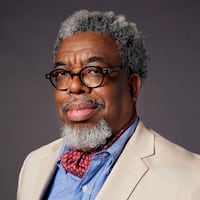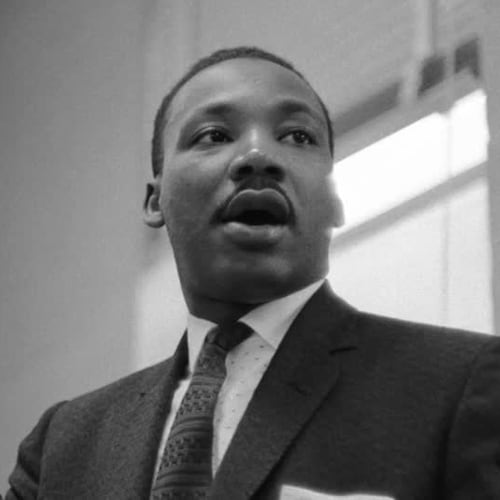Here is a moment of inside baseball.
Well into December, we were uncertain if the annual AJC Sepia Black History Month Series was going to happen.
Planning for this project — which generally features at least 28 stories with matching videos and fresh art — generally starts the previous fall to be ready by Feb. 1.
It is a lot of heavy lifting. But Black history, especially now, is important.
And nowhere is it more important and more relevant than here in Atlanta, the birthplace of the civil rights movement and the current epicenter of Black culture.
But 2020 was grueling. The pandemic forced all of the staff to work from home. And aside from covering that historic event, we also dealt with the country’s economic fallout, a major presidential election, a culture-shifting Senate race and months of protests targeting police brutality and racial injustice.
In a word, we were tired. And February was months, then still weeks away.
Credit: Ernie Suggs
Credit: Ernie Suggs
Then the staff, those who had put together the project for the last five years started asking questions. Why hadn’t they been giving assignments? What should I do? Do you have time to listen to my great story idea?
But by Feb. 28, we had gone from being doubtful about even having a series to perhaps having our best year in terms of story quality, depth and sophistication of our coverage.
Despite the challenges, we will not let our commitment to spotlighting such important history, people and places waver.
In case you missed any of the amazing stories that we told this year in the AJC Sepia’s Sixth Annual Black History Month Series, here is a recap:
The original premise of the series was to offer at least one story per day in our Metro or Living sections about the Black experience throughout February. Last year, we expanded that concept by providing the 28 daily stories, plus four deeply reported topical Sunday stories on the front page of the paper.
We tried something different this year.
Sunday Living
Credit: AJC archives
Credit: AJC archives
Instead of using A1 as an anchor, for the first time in the history of the project, we featured a series of four long-form feature stories in our Sunday Living & Arts section. With a focus on storytelling, we brought unique perspectives to overlooked and forgotten topics.
The first feature was on how Black midwives have been “catching babies” and carrying on traditions in Georgia for decades, but still have to fight for legitimacy.
Credit: thebirthstorycollective.com
Credit: thebirthstorycollective.com
For Valentine’s Day, we told the story of how John and Betty Sanford are still so much in love after challenging the state law that forbade interracial marriage 50 years ago.
Credit: Sanford family
Credit: Sanford family
That was followed by a story of how the West, in the decades following the Civil War, offered promise to Black homesteaders.
Credit: Arthur Rothstein / Library of Congress
Credit: Arthur Rothstein / Library of Congress
And we closed out that portion of the series with a personal essay about how the pandemic forced an AJC reporter to examine his Blackness and his family history through the growing of an Afro.
Credit: AP file
Credit: AP file
Front Page News
The series still found its way onto the front page of the paper. We had one A1 Sunday story. But it was an important one on how the COVID-19 pandemic — which has wreaked havoc on Black communities — exposes their long history of housing instability.
We also had a fascinating front-page story on the historic appointment of Lloyd Austin III as the first Black Defense Secretary. But that story also explored the Thomasville native’s unlikely connection with Henry Flipper, a former slave who became the first Black man to graduate from West Point.
Credit: HYOSUB SHIN / AJC
Credit: HYOSUB SHIN / AJC
“His story is one of courage, of perseverance and of commitment and of values,” Austin said of Flipper. “I have always been proud to say I am from the same town as Henry Flipper.”
Exploring Space
Keeping up with the theme of Blacks in the military, we wrote about Frederick Drew Gregory, a former U.S. Air Force pilot. But Gregory’s story goes further than that, as he later became the first Black man to command a space flight as one of a handful of Black NASA astronauts.
Credit: NASA
Credit: NASA
Along with legends like Ronald McNair and Guion Bluford, Gregory came to NASA with a gentle nudge from Lt. Nyota Uhura, the communications officer of the USS Enterprise.
Played by Nichelle Nichols in “Star Trek” TV and movie franchise from 1966 until 1991, the character became a symbol of Black excellence and possibilities during the height of the civil rights movement.
So much that when Nichols threatened to quit the show, Martin Luther King Jr. convinced her otherwise.
“For the first time,” King told her. “The world sees us as we should be seen, as equals, as intelligent people — as we should be.”
Credit: Paramount Television
Credit: Paramount Television
Nichols stayed. And when she did leave the show, she worked with NASA to recruit women and Blacks into the space program.
“The first time I met Nichelle Nichols, she was inside my television saying, ‘I want you to be an astronaut,’” Gregory said. “Others may claim she was looking at them, but no, she was looking at me.”
Civil Rights Mothers
Despite the fact that Nichols served as a role model and visible, albeit unlikely, civil rights figure, there were dozens of Black women who worked in the shadows of the movement.
Credit: Library of Congress
Credit: Library of Congress
Often overlooked by the work of high-profile men, this series brought those women to the forefront. Like Septima Clark, who was called the “Mother of the Movement,” because of her groundbreaking and pioneering work in grassroots citizenship education.
Credit: AP
Credit: AP
And then there was Ella Baker, who worked at the NAACP before helping to start both the Southern Christian Leadership Conference and the Student Nonviolent Coordinating Committee, which helped coordinate galvanizing incidents such as the Freedom Rides on buses throughout the South and Black voter registration drives.
Pulitzer Prize winners
Kendrick Lamar was born in Compton in June of 1987. Three months later, Toni Morrison dropped her classic novel “Beloved.”
A year later, “Beloved,” the story of a family of former slaves whose home is haunted by a malevolent spirit, earned Morrison the Pulitzer Prize.
Credit: AP
Credit: AP
Morrison, who also won a Nobel Prize for Literature, still influences a legion of Black writers with her gripping stories about the Black experience, trauma and how she paints the harsh consequences of racism in America.
The same experiences, trauma and consequences that Kendrick Lamar lives and now raps about ― brushes with the law, systemic racism, the grip of poverty, gangs and heavy-handed police officers.
So beautiful and profound was his prose, told over a thumping beat, that in 2018, exactly 30 years after Morrison’s win, Lamar got his own Pulitzer.
Speaking of Lamar, it should be noted that the same year he won the Pulitzer, he helmed the soundtrack to the phenomenal “Black Panther” movie.
Lamar gave the Black hero a voice, but Ruth E. Carter, the legendary Hollywood costume designer, gave T’Challa his iconic look. And for that, Carter became the first African American to win an Academy Award for costume design.
Superheroes
The Black Panther was fictional, but we featured our share of real-life heroes. Like Claude Mundy, one of Atlanta’s first Black police officers, when he was sworn in, as part of the second class of Blacks in 1950. In 1961, after 11 years of dealing with racism, including the indignity of not being allowed to dress with white officers, Mundy became the first Black APD officer killed in the line of duty.
Credit: Family Photo
Credit: Family Photo
And then there was Bass Reeves, whom some believe the Lone Ranger was modeled after. A mountain of a man who stood well over 6 feet tall and sported a bushy walrus-styled mustache, as he patrolled the Indian Territory of what is now Oklahoma as a deputy U.S. marshal from 1875 to 1907.
Credit: Wikimedia Commons
Credit: Wikimedia Commons
Saving Lives
We did a piece on Vivien Thomas, who designed groundbreaking surgical equipment, developed lifesaving surgical techniques and trained countless doctors. That’s impressive for anyone, but even more so for a Black man in the segregated South who never went to college, was classified as a janitor and stood in the shadows.
Credit: Ric Watkins
Credit: Ric Watkins
In many ways, a generation later, it was easier for Terrence Ferguson and Vernard Hodges. The historically Black college graduates are popular and well-known veterinarians who have become television stars with their National Geographic show, “Critter Fixers: Country Vets.”
Credit: National Geographic
Credit: National Geographic
There is no doubt that their work in veterinary medicine will be influenced by the efforts of U.S. Rep. David Scott, U.S. Rep. Sanford Bishop and U.S. Sen. Raphael Warnock. All Georgians, and with the COVID-19 pandemic ravaging minority communities especially, 17 million children living in hunger, rural communities struggling without broadband access and Black farmers, in particular, hit by natural disasters, trade wars and COVID hurdles, they have become three of the most powerful voices in American agriculture.
On and off the court
Popularity was never a problem for the Harlem Globetrotters, whose half-court shots and on-court shenanigans have thrilled millions of basketball fans all over the world. They are still doing it after 90 years, even from their surprising new home.
Other than being 7 feet, 7 inches, there was nothing funny about Manute Bol’s game on the basketball court. One of the most unique figures in the history of the NBA, we tell the story about his life off the court, where he raised millions of dollars to help victims of the civil war in his native Sudan, including donations of at least a million of his own money.
ATL and Georgia
Atlanta and Georgia were well-represented, as always.
In fact, we kicked off this year’s series with a piece on the historic Ashby Theater, the Westside movie house that brought movies to a Black audience in the age of segregation.
The theater was located in Washington Park, which was also featured in a story about current efforts by residents to preserve the “living history,” of the iconic Black neighborhood.
By the time the Ashby Theater opened in 1934, Columbus’ Ma Rainey was wrapping up her career as the “Mother of the Blues.” She stopped touring in 1935 and moved home to open her own local theater owner.
Today, Chef Mashama Bailey is also doing her own thing to bring a “little bit of Black Power,” with the opening of her acclaimed Savannah restaurant the Grey and the release of her book, “Black, White, and the Grey.”
When all was said and done, we ended up with 24 new original stories and seven stories from our five previous years of archives, which have been indexed on our new Black History Month Page.
Now, on to 2022.
About the Author
The Latest
Featured



















